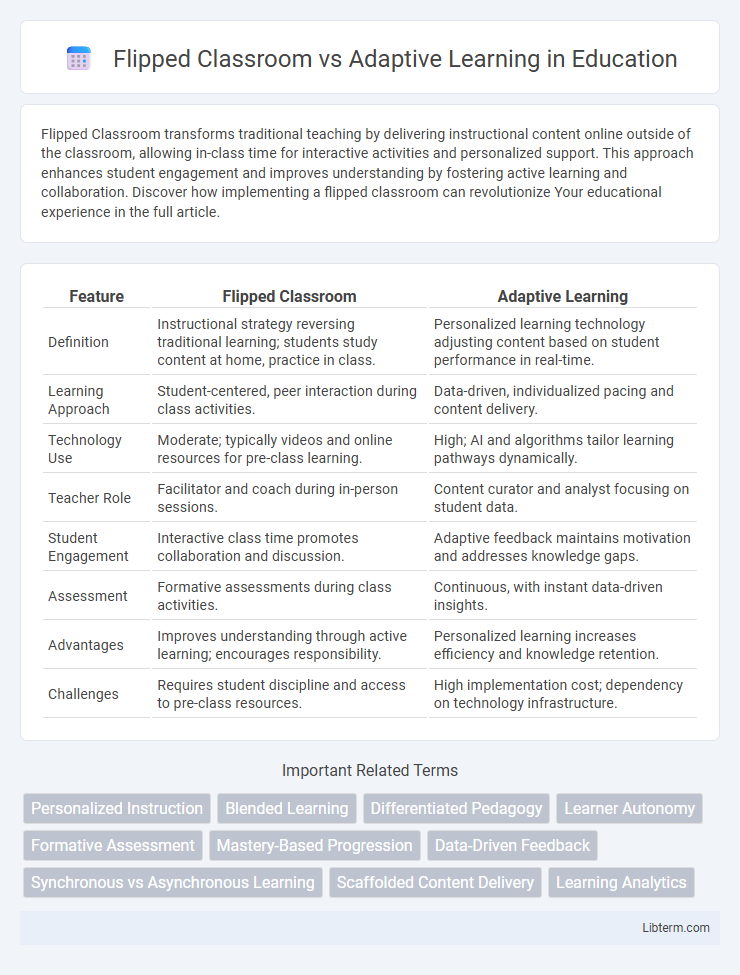Flipped Classroom transforms traditional teaching by delivering instructional content online outside of the classroom, allowing in-class time for interactive activities and personalized support. This approach enhances student engagement and improves understanding by fostering active learning and collaboration. Discover how implementing a flipped classroom can revolutionize Your educational experience in the full article.
Table of Comparison
| Feature | Flipped Classroom | Adaptive Learning |
|---|---|---|
| Definition | Instructional strategy reversing traditional learning; students study content at home, practice in class. | Personalized learning technology adjusting content based on student performance in real-time. |
| Learning Approach | Student-centered, peer interaction during class activities. | Data-driven, individualized pacing and content delivery. |
| Technology Use | Moderate; typically videos and online resources for pre-class learning. | High; AI and algorithms tailor learning pathways dynamically. |
| Teacher Role | Facilitator and coach during in-person sessions. | Content curator and analyst focusing on student data. |
| Student Engagement | Interactive class time promotes collaboration and discussion. | Adaptive feedback maintains motivation and addresses knowledge gaps. |
| Assessment | Formative assessments during class activities. | Continuous, with instant data-driven insights. |
| Advantages | Improves understanding through active learning; encourages responsibility. | Personalized learning increases efficiency and knowledge retention. |
| Challenges | Requires student discipline and access to pre-class resources. | High implementation cost; dependency on technology infrastructure. |
Introduction to Flipped Classroom and Adaptive Learning
The Flipped Classroom model reverses traditional teaching by delivering instructional content online outside of class, allowing in-person sessions to focus on interactive, practical application and personalized support. Adaptive Learning employs technology-driven systems that analyze individual student performance data to tailor educational content, pacing, and feedback dynamically. Both approaches prioritize student-centered learning but differ in methodology: Flipped Classroom emphasizes restructuring the learning environment, while Adaptive Learning focuses on customizing the learning path through real-time data analytics.
Core Principles of Flipped Classroom
The flipped classroom centers on reversing traditional teaching by delivering instructional content outside of class, allowing in-person sessions to focus on interactive, student-centered activities that enhance understanding. This model emphasizes active learning, collaboration, and formative assessment to foster deeper engagement and personalized feedback. Core principles include pre-class content consumption, in-class application, and continuous teacher guidance to support mastery of concepts.
Key Features of Adaptive Learning
Adaptive learning utilizes algorithms and data analytics to personalize educational content, adjusting in real-time to each student's strengths, weaknesses, and learning pace. Key features include dynamic content customization, continuous assessment through formative quizzes, and targeted feedback that enhances individual learning outcomes. This approach contrasts with the flipped classroom model by offering a more individualized learning path rather than a uniform pre-class preparation.
Differences in Instructional Approach
The flipped classroom model reverses traditional teaching by delivering instructional content online outside of class, allowing in-person sessions to focus on exercises and discussions. Adaptive learning utilizes data-driven algorithms to tailor educational content and pacing to individual learner needs in real-time. Unlike the flipped classroom's fixed content delivery schedule, adaptive learning dynamically adjusts instructional pathways based on learner performance metrics.
Student Engagement: Flipped Classroom vs Adaptive Learning
Flipped Classroom boosts student engagement by encouraging active learning through pre-class video lectures and in-class collaborative activities, fostering critical thinking and peer interaction. Adaptive Learning personalizes content based on real-time performance data, keeping students motivated by targeting individual knowledge gaps and pacing. Both methods enhance engagement but differ as Flipped Classroom emphasizes social interaction, while Adaptive Learning focuses on personalized progression.
Technology Requirements and Tools
Flipped Classroom models primarily require video recording and streaming platforms such as YouTube or Panopto, along with learning management systems (LMS) like Canvas or Moodle to deliver pre-class content and manage assignments. Adaptive Learning relies heavily on AI-driven software like Knewton or Smart Sparrow, which use algorithms to personalize content in real-time, demanding robust data analytics and cloud computing environments. Both methods benefit from reliable internet connectivity and devices like tablets or laptops, but Adaptive Learning necessitates more advanced backend infrastructure to dynamically adjust learning pathways based on student performance.
Benefits and Challenges of Flipped Classroom
The flipped classroom enhances student engagement by shifting lectures outside of class, allowing in-person time for interactive activities and personalized support, which improves comprehension and critical thinking skills. Challenges include the need for students' self-discipline to complete pre-class work and potential technology access issues that can create disparities. Effective implementation requires robust digital resources and teacher training to manage classroom dynamics and monitor student progress.
Advantages and Limitations of Adaptive Learning
Adaptive learning systems offer personalized educational experiences by dynamically adjusting content based on individual learner performance and preferences, increasing engagement and knowledge retention. They provide real-time feedback and targeted interventions, fostering mastery of concepts at an individualized pace, which enhances learning efficiency especially in diverse classrooms. Limitations include high initial development costs, dependence on accurate learner data for effectiveness, and potential challenges in addressing complex, nuanced understanding compared to human-guided instruction.
Impact on Learning Outcomes
Flipped Classroom models enhance learning outcomes by promoting active student engagement and allowing personalized in-class support from instructors, leading to improved comprehension and retention. Adaptive Learning systems leverage data-driven algorithms to tailor content and pacing to individual student needs, resulting in higher mastery levels and reduced achievement gaps. Studies indicate that combining these approaches maximizes effectiveness by integrating personalized feedback with collaborative, student-centered learning environments.
Choosing the Right Approach for Your Educational Goals
Selecting between Flipped Classroom and Adaptive Learning depends on your educational goals and student needs; Flipped Classroom excels in fostering active engagement through pre-class content review and in-class collaboration, while Adaptive Learning customizes instruction based on individual progress and performance data. For skills development and interactive discussions, Flipped Classroom promotes deeper understanding, whereas Adaptive Learning efficiently addresses diverse learning paces with personalized content. Aligning the approach with objectives such as enhancing critical thinking or mastering foundational concepts ensures optimal outcomes in your teaching strategy.
Flipped Classroom Infographic

 libterm.com
libterm.com